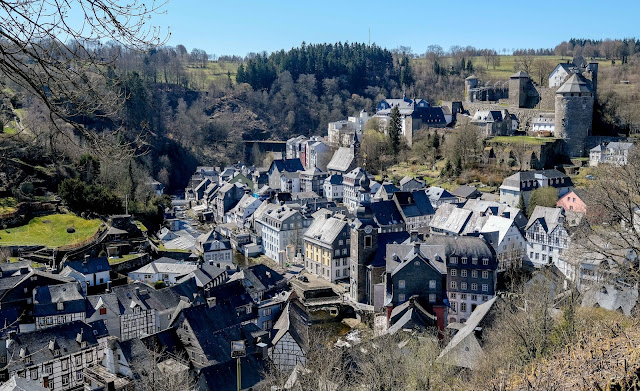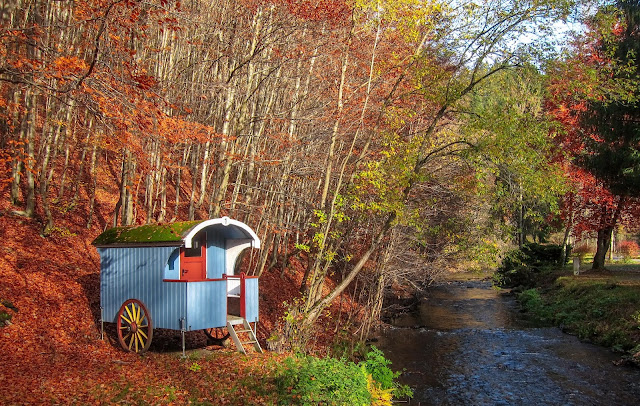Monschau is a little German town at the edge of the High Fens (fr: Hautes Fagnes; de: Hohes Venn), sitting at the border to Belgium and next to a large National Park. The mountainous area is called the Eifel in Germany, and the Ardennes in Belgium. (click on an image to enlarge)
Detail of Monschau
Monschau, with its castle on the right top
Monschau is built along a winding stream, the Rur. The waters that run off the High Fens are soft and ideally suited for the cloth factories that established themselves 400 years ago. In the early 1900s, the factories were no longer competitive and closed.
Today, Monschau is a touristic destination, especially for our Dutch neighbors, who enjoy the bubbling streams, timber-framed houses, and surrounding nature. A typical souvenir is the mustard "made in Monschau".
In summer, Monschau teems with tourists. The Christmas Market used to attract visitors from far, but has been closed for the past two years because of the pandemic.

The castle of Monschau contains a youth hostel....
The old town of Monschau has only 700 permanent residents. Together with six villages on the surrounding windswept hills they make up the Monschau community of fewer than 10,000 people.
The first sign of spring arrives with the daffodils, which are endemic to our valleys.
Now is the time to dust off your bike and go exploring.
In earlier days, the people of the area collected and sold the Daffodils. Now they are protected and attract thousands of visitors in each season.
The small timber-framed house is very typical for our villages, as are the hedges grown from beeches. The hedges require a lot of care, and can grow several meters tall. They protect the houses from strong winds.
Because of the persistent wind on the high plateaus, our area is ideally suited for wind turbines. They have become a feature of our surroundings. Just about one quarter of all energy used in Germany is generated by wind turbines.
Measures for environmental protection, ecological restoration and sustainable tourism are vigorously pursued and enforced on both sides of the border by the authorities of Germany and Belgium, and often funded by the European Union.
Old railway lines have been transformed into long-distance bicycle routes, of which several pass through the Monschau area. One can travel for hundreds of kilometers, with very little gradients and undisturbed by road traffic, up to Luxembourg and France. The bicycle routes are a favorite among retirees, and suitable overnight stops can be found in almost every village along the way.
Did you ever try Shinrin-Yoku? The Eifel National Park, which starts at our doorsteps, allows you to 'bath in the forest', which means as much as taking in the forest atmosphere during a leisurely walk.
Detox - with Nature TV
For the big views, take the big seat.
Our village sits right on the border, and we venture as often into Belgium as anywhere on the German side. From our home office window, we can see the highest point of Belgium, in the knowledge that an excellent beer is brewed nearby.
The Hautes Fagnes (High Fens) are a raised bog. Mosses and grass grow on top of each other and turn into peat. For the strong winds blowing eastward from the Atlantic, the area is the first significant elevation and it is frequently shrouded in mist and low clouds.
The waters coming out of the fens are very soft, or low in calcium carbonate. This made them so suitable for the cloth factories. The water running from the 'Hohes Venn' are decidedly black, as seen here in the 'Black Lake'.
A typical stream running off the High Fens.
The 'High Venn' remains a bog. In many places, board walks have been fitted to allow safe passage. Stories abound of people disappearing into the bog - or getting stuck and freezing to death.
But the High Venn is a delight for the intrepid hiker...
... and a paradise for suitably equipped bicyclists, especially those with an e-bike.
Some of the fiercest battles of World War II were waged here or nearby. Above the propeller of a crashed aircraft. Countless monuments are everywhere - of young people loosing their lives: Americans, British, Russians, Belgians and Germans. Everyone agrees that never again shall war be allowed to take over.
Today there is no border anymore, and one may not notice of having crossed from one country into the other. It has not always been like this. Here is the monument to the smugglers who brought goods from Belgium into Germany after the war. They helped their people in the border villages to survive.
This is Kalterherberg, where we live. The village is part of Monschau and has 2000 residents. It is in walking distance of the old town, and its existence has been documented as far back as 1334. The name means 'cold hostel'. It has a landmark twin tower church.
I developed this logo for the community of Kalterherberg, combining the landmark twin towers with the community's ambition to become a center for bicycle holidays in the region. As a bumper sticker, it can be found on most cars in Kalterherberg.
The sticker is also used for the bottles of the self-service 'milk station', where one can collect fresh milk from the local farm.
The village does not have many amenities. The 'chickeria' provides free-range eggs and cheese any time of day or night.
Meanwhile, autumn has come, and the many holiday homes are closing down.
Autumn is the most colorful of all seasons in the area, and still good for exploring the lakes and the mountains.
The beech hedges turn brown ....
... as does the hydrangea in our yard.
Luckily, the local bakery remains open, with its usual assortment of 'Brötchen' (rolls) typical for our area, freshly baked several times a day.
Time for the last bicycle outings...
... and walks in the foggy forests.
And suddenly, winter has come.
The school in Kalterherberg has closed for good, four years ago, for lack of children. The premises and buildings can be leased for 1 Euro, provided the buyer has an investment plan. The remaining children of Kalterherberg now attend school in a neighboring village.
A school-aged child walking home from the bus station. Meanwhile, birth rates have gone up, and there is a fully functioning kindergarten. There even is a waitlist.
Other photo-stories by Detlef:
- Lunae Montes - a journey to the source of the Nile, in 1980
- The Somalia Experience
- Operation Lifeline Sudan, the first years in pictures
- A Walk on the Wild Side (New York)
- The Door to Hell and the Path to Health (Turkmenistan)
- Into the Midnight Sun (Journey to the North Cape)
- Top of Mexico
- Magic South (Southern Africa)
- Azhdahak (from Germany to Armenia, by road)
Detlef can be contacted via detlefpalm55@gmail.com







































Detlef, You have captured an amazing collection of images - some of them are like from our childhood fairy tale books! Perhaps we need to plan our next XUNICEF reunion here ? Thanks for sharing.
ReplyDeleteThe photography is superb - but it means that you are a hard act to follow. On the plus side, I put Kalterherberg on Google Maps which means that when I get a chance to travel, I know one of the places I intend visiting. Thanks for this.
ReplyDeleteDetlef, thanks for sharing the lovely pictures and its surroundings. Your commentary gave life and meaning to the pictures. Now I know the secret for your cheer, intellectual alacrity and dynamism which keeps us editors going. It seems an ideal place for a reunion.
ReplyDeleteThanks for sharing, Detlef. Great pictures! We must have passed very close to Kalterherberg several times in recent years when going from Austria/Germany to England by road, without realising of course . We usually go via Belgium (near Charleroi) where Annelore has relatives. We are overdue for a visit to the UK, so next time we go we'll have to stop and say hello!
ReplyDeleteTad
Please do!
DeleteBeautiful. Love it
ReplyDeleteAn amazing place. Thanks, Detlef. Wished I had known about it years ago. And your photos are fantastic.
ReplyDeleteFantastic photos and write up Detlef !! An idyllic place to live in!!! Thanks for giving us a glimpse 🌹😊
ReplyDeleteI wonder if the designer of the bench to take in the 'Big View' was reading Gulliver's Travels when he got the idea ?
ReplyDeleteWhat an excellent storyteller you are! Just lovely work!
ReplyDeleteThanks so much for this Detlef I really enjoyed the beautiful pictures and stories about your many travels!
ReplyDeleteSo much green power - wind turbines, hydroelectric, and a water wheel. Imagine the impact of mitigating the existential threat of climate change if the $ 170 billion annual global aid budget was spent on providing renewable energy to the ones without any power. If it was done commercially through the private sector it would be sustainable. It could even generate economic growth something aid has by and large failed to do. Economic growth may in turn provide the foundation for education and health care as it has done throughout history.
ReplyDeleteThomas Ekvall
Awesome setting, amazing narrative! The place comes to life as you read through. Yes, that's the kind of place we would love to visit for our next Reunion. I ditto Doreen's and Sree's sentiments on that. You continue to inspire, Detlef!
ReplyDeleteDear Detlef thank you for sharing! Your story telling is amazing, very powerful and absorbing ...and the pictures are simply beautiful!
ReplyDelete